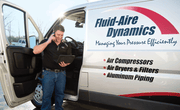Compressed air is the “fourth utility” for manufacturers—and by far the most expensive. But there are ways to reduce the cost of compressed air. Increasing the efficiency of your compressed air system could save thousands on your energy bills every year. Here are the top five opportunities for compressed air savings.
Find and Fix Leaks
Compressed air leaks may start small, but they can quickly add up to a big problem. Leaks in your compressed air system can increase the energy costs for your compressed air system by 30% or more.
How much does a compressed air leak cost? A 1-CFM leak costs about $35/shift annually–and your compressed air system may have hundreds of leaks. That can add up to thousands of dollars each year. In fact, some studies have shown that up to 35% of compressed air is wasted on average.
To cut down on energy costs for compressed air, find and fix leaks in your system. You may be able to find some yourself, by simply listening for the tell-tale hiss at the leak site. Hoses, fittings and connectors are common culprits for air loss. But to find smaller leaks, you will likely need to call in a professional for a compressed air system audit. During the audit, the technician will use an ultrasonic acoustic detector to pinpoint leaks too small to detect using human senses. Once the leaks are identified, they can be addressed by tightening connections, replacing faulty fittings, or patching or replacing damaged sections of piping.
Leaks can develop at any time, so this is not a one-time fix. Your system should be inspected for leaks on a regular basis. Fortunately, you may be able to fix compressed air leaks for free through energy incentives offered by your power company. Contact us if you’d like to find out more.
Check Plant Pressure
Your second opportunity for big energy savings in your compressed air system is checking the overall plant pressure. Many plants are operating at higher pressures than they need to run tools and equipment. There is no benefit to operating at higher pressures than required for efficient equipment operation. Reducing plant pressure could save hundreds or thousands on your energy bill each year.
On average, a 2 PSI reduction in overall plant pressure saves 1% in energy costs for the compressed air system. And many plants are operating at pressures 15 to 20 PSI above what they really need. Lowering plant pressure by just 10 PSI could reduce compressed air energy bills by 5% or more.
Why are manufacturing facilities operating at higher PSIs than necessary? Excessive pressure drop is one of the big culprits. This may be due to leaks in the compressed air distribution system (see above) or a result of loaded inline filters or other blockages in the system. To compensate for pressure drop at the end of the lines, manufacturers may simply raise the PSI for the whole system so that tools at the end of distribution runs operate correctly. However, fixing the cause of pressure drop and lowering PSI is almost always more cost-effective in the long run.
Eliminate Wasteful Air Uses
Leaks aren’t the only cause of compressed air waste in many facilities. Wasteful uses of compressed air can add hundreds of dollars to your annual energy bills. Some of the most common culprits are:
- Clean-up/blow-off
- Drying or process cooling
- Sparging
- Personal cooling
In each of these cases, compressed air is a relatively expensive way to solve the problem at hand. It may be more convenient (or fun) to blow sawdust off a workstation than to pick up a brush or a broom, but it is not the best use of compressed air or the most effective way to clean. And applications like drying, cooling or sparging don’t require compressed air. Regular fans or blowers are better suited for these processes. Before using compressed air for an application, ask whether pressurized air is truly required and if there are better (and cheaper) ways to achieve the goal.
Idle equipment can be another source of compressed air waste. Small leaks in valves or couplers supplying air to the equipment can result in air loss even when equipment is not running. Disconnect unused equipment from your compressed air system and turn off the air valves for equipment that is sitting idle for extended periods of time.
Reducing compressed air waste may require some retraining for employees. Small changes in behaviors and processes can make a big difference in overall air use.
Stay on Top of Maintenance
Maintenance is essential for an industrial compressed air system. Regular preventative maintenance will improve the energy efficiency of your system and reduce operating costs.
Blocked or loaded compressed air filters, in particular, can be an energy drain in your compressed air system. As filters become loaded with particulate, it takes more energy to move air through them. This becomes evident as pressure drop across the filter. When you don’t change your filters often enough, your compressed air system has to work harder.
Compressed air inline filters should be changed at least once a year or after 8,000 hours of operation. If the intake air is very dirty, or you are experiencing high oil carryover from your compressor, they may need to be changed more often. Also check and change the air intake filter on a regular basis.
In addition to performing all standard PM activities for the compressor, make sure the area around the compressor is clean and allows for adequate airflow to prevent compressor overheating. Keeping the area around the compressor clean will reduce the particulate that ends up in your filters, extending filter life. Also inspect your distribution system to make sure there are no blockages from corrosion or other contaminants in the system. A clean, well-maintained compressed air system will run at maximum efficiency.
Consider a VSD Air Compressor
If your compressed air usage varies over the course of a shift, day or season, you may benefit from a variable speed drive (VSD) air compressor. A VSD compressor ramps the speed of the motor up or down in response to real-time demand. That means when demand is lower, the motor is running at a reduced speed, which saves energy. This is in contrast to a fixed-speed air compressor, which is always operating at maximum capacity, even when air demand is low. In some circumstances, a VSD compressor can slash energy consumption by up to 70%!
A VSD compressor provides maximum savings for facilities with variable compressed air use. Fully robotic facilities using compressed air at the same rate 24/7/365 may not see as much benefit from switching to a VSD compressor. But for facilities with intermittent air use across the day or big swings in demand from season to season, a VSD can take a big bite out of energy bills.
Best of all, your energy company may cover some or all of the cost of switching to a VSD compressor. Energy incentives offered by many power companies will offset the cost of upgrading.
Let Fluid-Aire Dynamics help you cut your compressed air energy costs. Contact us for a free consultation.




